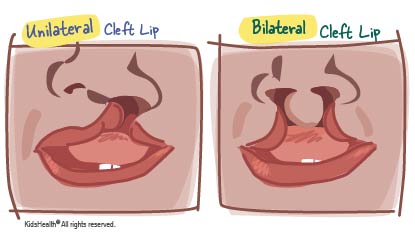Cleft Lip
What Is a Cleft Lip?
Babies who are born with cleft lip have a gap or opening in the upper lip. This happens when the baby's lip doesn't form properly early in pregnancy, resulting in a split.
These orofacial clefts are some of the most common birth defects. Most kids can have surgery to repair them early in life.
A baby with a cleft might have:
- only a cleft lip
- only a cleft palate
- both a cleft lip and a cleft palate
A cleft lip can be:
- on one side of the lip (a unilateral cleft lip). This type is more common.
- on both sides of the lip (a bilateral cleft lip)
Clefts can range in size:
- Some are just a small notch in the lip (an incomplete cleft lip).
- Others extend completely through the upper lip and gum into the nostril (a complete cleft lip). This can make the baby's nose look wider and shorter than normal, especially when there are clefts on both sides of the lip.
What Causes Cleft Lip?
During the first 6 to 10 weeks of pregnancy, the bones and skin of a baby's upper jaw, nose, and mouth normally come together (fuse) to form the roof of the mouth and the upper lip. A cleft lip happens when parts of the upper lip and/or gum do not fuse together completely.
Doctors don't always know why a baby develops a cleft lip, though some clefts may be related to genetic (inherited) factors. Also, some environmental factors can increase the risk of a birth defect, such as:
- taking certain medicines (such as some anti-seizure medicines) during pregnancy
- not getting the right amount of prenatal nutrients, such as folate
- exposure to some chemicals during pregnancy
- smoking cigarettes, using drugs, and/or drinking alcohol during pregnancy
How Is a Cleft Lip Diagnosed?
Usually, cleft lip is found when a baby is born. Sometimes, it's seen before the baby is born on a prenatal ultrasound.
Cleft lip can be associated with feeding problems. Later in life, it may lead to dental problems, speech problems, and even issues with self-esteem and social interactions. It's important to correct a cleft lip with surgery while a child is young.
How Is a Cleft Lip Treated?
Most babies who have a cleft lip have a surgery called cheiloplasty (KY-lo-plass-tee) to repair it when they're about 3 months old. This is done in the hospital while the baby is under general anesthesia.
The goals of cleft lip repair are to:
- Close the cleft.
- Create a more normal shape and contour of the upper lip and nose.
If the cleft lip is wide, special procedures like lip adhesion or nasal alveolar molding (NAM) might help bring the parts of the lip closer together and improve the shape of the nose before the cleft lip repair. Cleft lip surgery usually leaves a small scar under the nose in place of the cleft.

When Should I Call the Doctor?
Cleft lip repair and other surgeries to help kids born with a cleft lip have greatly improved in recent years. Most kids who undergo them have very good results. There are risks with any surgery, though, so call the doctor if your child:
- has a fever above 101.4˚F (38.5°C)
- has lasting pain or discomfort
- has heavy bleeding from the mouth
- can't drink fluids
What Else Should I Know?
A baby with a cleft lip can sometimes have other health problems, such as:
- trouble feeding
- dental problems
- speech problems
It's important to work with a care team experienced in treating children with cleft lip and palate. Besides the pediatrician, a child's treatment team should include:
- a patient care coordinator
- cleft surgeon (pediatric plastic surgeon or oromaxillofacial surgeon with cleft care experience)
- ear, nose, and throat (ENT) physician (otolaryngologist)
- orthodontist
- speech-language pathologist
- audiologist
You might also work with:
Some children with cleft lip may need more surgeries as they get older. These might include:
- Alveolar (al-VEE-eh-lur) bone grafting: Doctors might use a small amount of bone from the hip to repair the cleft or notch in the gums and to support the permanent teeth as they come in. This surgery is usually done when kids are 7–9 years old.
- Nose surgery: Clefts of the lip also affect how the nose looks, so some kids may benefit from more surgery on the nose. Fixing minor problems, such as the shape of the nostrils, can be done during childhood. More extensive nose surgeries, if needed, are done when the child is finished growing.
- Orthognathic (or-thig-NATH-ik) surgery: Some children with cleft palate need this surgery to realign the jaws and teeth when they're older. It's done when the child is finished growing.
Looking Ahead
Most kids with cleft lip are treated successfully with no lasting problems. A team experienced in treating children with cleft lip and palate can create a treatment plan tailored to your child's needs.
The psychologists and social workers on the treatment team are there for you and your child. Turn to them to help guide you through any hard times. You also can find more information and support online:
